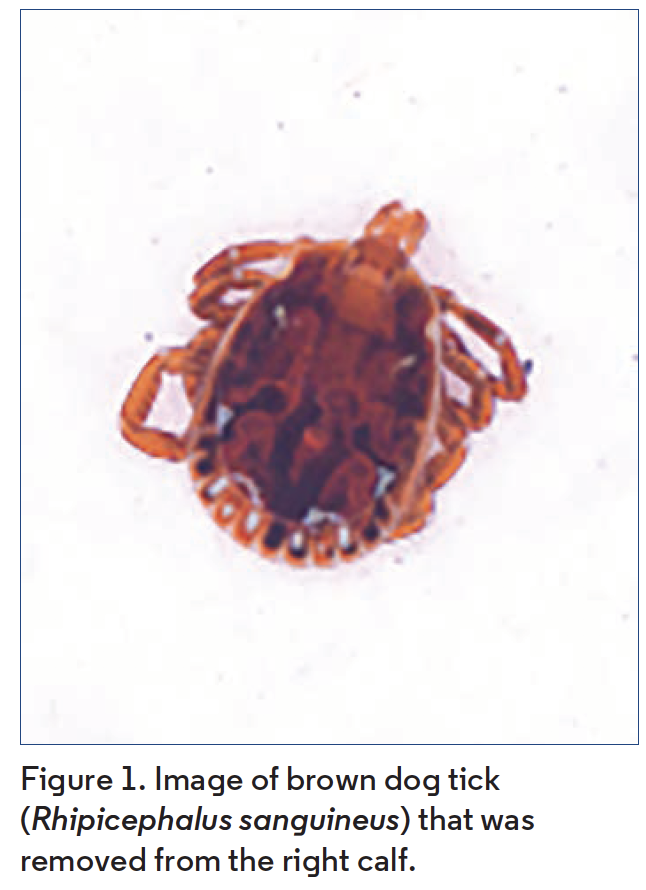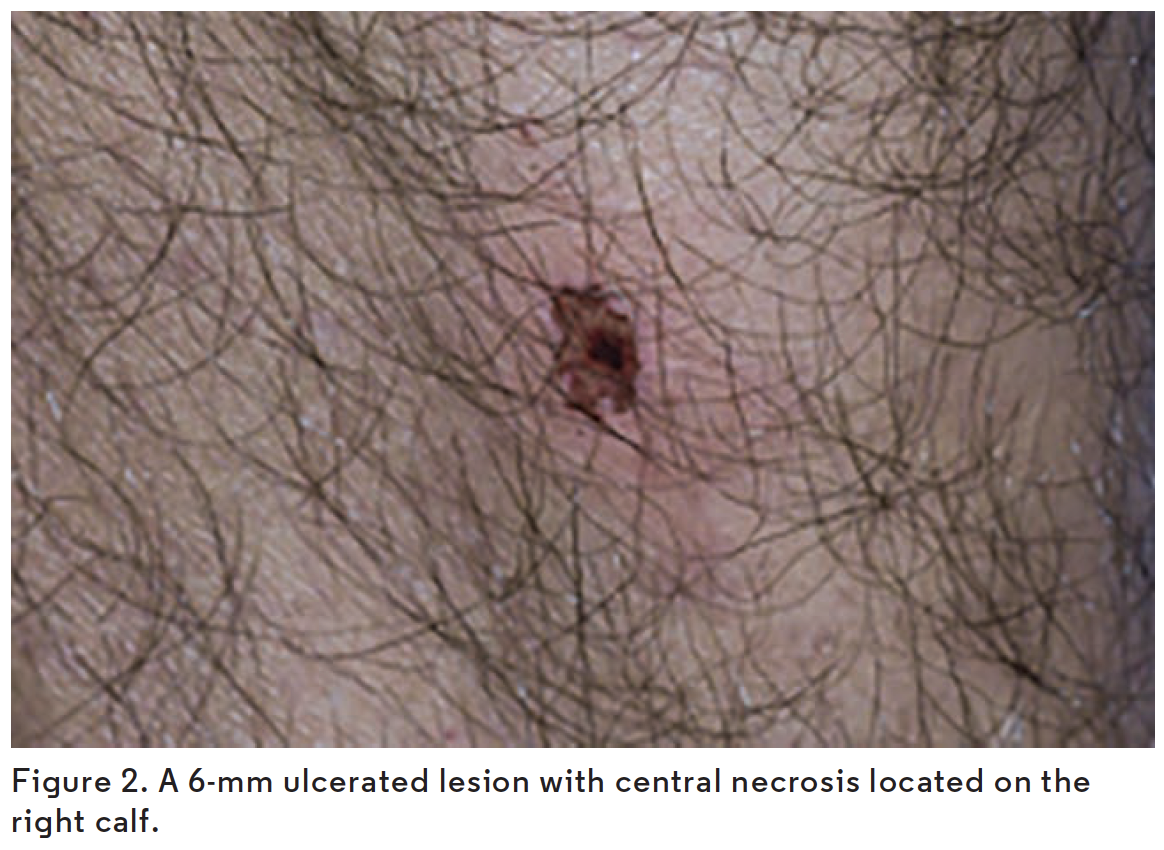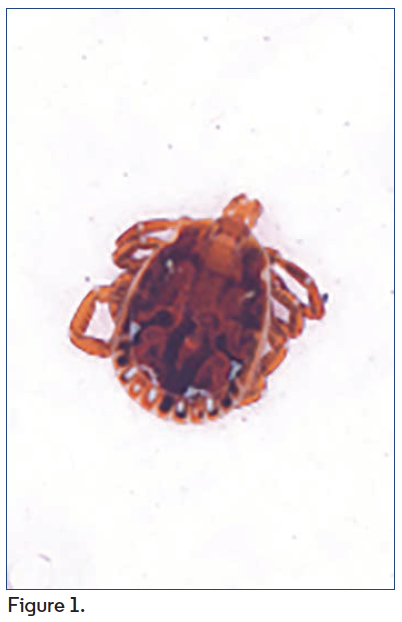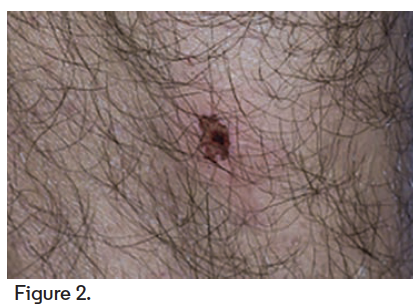Diagnosis: Mediterranean Spotted Fever (MSF)
MSF is a rare, tick-born zoonotic disease caused by Rickettsia conorii. There are less than 400 cases reported annually, mostly occurring from June through September.1,2 This rickettsial disease gets its name due to being endemic to regions that surround the Mediterranean Sea, including southern Europe and northern Africa.
Etiology
 R conorii is transmitted to humans by the bite of an infected brown dog tick (Rhipicephalus sanguineus; Figure 1).3 After the tick attaches to a host, the bacteria replicates in the cytoplasm of endothelial cells and releases proinflammatory cytokines, leading to clinical symptoms.1
R conorii is transmitted to humans by the bite of an infected brown dog tick (Rhipicephalus sanguineus; Figure 1).3 After the tick attaches to a host, the bacteria replicates in the cytoplasm of endothelial cells and releases proinflammatory cytokines, leading to clinical symptoms.1
Symptoms
MSF is characterized by the abrupt onset of fever and headache, followed by a maculopapular skin rash and black eschar at the site of the tick bite, also known as tache noire (Figure 2).4 The rash is present in 97% to 99% of reported cases and tache noire in approximately 70%.4 Other signs and symptoms may include arthralgias, myalgias, hepatosplenomegaly, gastrointestinal symptoms, and conjunctivitis.
Diagnosis and Prognosis
The diagnosis can be made based on the aforementioned clinical findings along with a consistent history as well as an immediate response to doxycycline. In addition, serologic studies can be done using indirect immunofluorescence against R conorii; however, this is typically done retrospectively to confirm the diagnosis (a titer of at least 1:64 is diagnostic for MSF).4 Therefore, the clinical and epidemiologic factors play an important role in the initial management of MSF. Although MSF usually runs a benign course in children, late initiation of proper treatment can lead to mortality rates as high as 21%, especially in adults who are prone to more severe infection.1 Central nervous system involvement has been reported.1
There are a number of rickettsial diseases that can present in a similar fashion to MSF. However, based on geographic location, species of tick involved, and the presence of tache noire, we can be fairly certain in the diagnosis of MSF. R conorii is the most common pathogenic rickettsial organism in the Mediterranean region. Infection by R conorii subsp israelensis is on the differential and, without serologic confirmation, is hard to rule out. This organism causes Israeli spotted fever (ISF) and is transmitted to humans by the same brown dog tick as MSF. In contrast to MSF, the absence of tache noire is typical in ISF. Cases of ISF have been reported in Italy and Portugal.1
Treatment
Tetracyclines or chloramphenicol are the first-line treatments and have good antirickettsial activity.1 In children younger than 8 years, macrolides are the antibiotics of choice due to their safety and efficacy against rickettsial organisms. Symptoms generally improve soon after initiation of the proper treatment.
Our Patient
 Confirmatory serology was not performed on this patient. However, given the consistent symptoms, clinical findings of tache noire and macular rash, discovery of the brown dog tick, and rapid improvement of symptoms upon initiation of doxycycline, we can be confident in the diagnosis of MSF. Several weeks after resolution of the illness, this patient had neither residual symptoms nor any complications from the infection. The tache noire has developed into scar tissue.
Confirmatory serology was not performed on this patient. However, given the consistent symptoms, clinical findings of tache noire and macular rash, discovery of the brown dog tick, and rapid improvement of symptoms upon initiation of doxycycline, we can be confident in the diagnosis of MSF. Several weeks after resolution of the illness, this patient had neither residual symptoms nor any complications from the infection. The tache noire has developed into scar tissue.
Conclusion
MSF is a rare rickettsial disease endemic to the regions surrounding the Mediterranean Sea. It classically presents with sudden onset fever, maculopapular rash, and tache noire at the site of a previous bite by the brown dog tick. Since early initiation of proper treatment leads to a good prognosis, proper history and full body skin examination are imperative to making the proper diagnosis.
Mr Marghoob is a medical student at the New York Institute of Technology College of Osteopathic Medicine in Glen Head, NY. Dr Marghoob is a dermatologist at Memorial Sloan Kettering Cancer Center in Hauppauge, NY.
Disclosures: The authors report no relevant financial relationships.
References
1. Colomba C, Saporito L, Polara VF, Rubino R, Titone L. Mediterranean spotted fever: clinical and laboratory characteristics of 415 Sicilian children. BMC Infect Dis. 2006;6:60. doi:10.1186/1471-2334-6-60
2. Gomez-Barroso D, Vescio MF, Bella A, et al. Mediterranean spotted fever rickettsiosis in Italy, 2001-2015: Spatio-temporal distribution based on hospitalization records. Ticks Tick Borne Dis. 2019;10(1):43-50. doi:10.1016/j.ttbdis.2018.09.001
3. Torpiano P, Pace D. Clinically-diagnosed Mediterranean spotted fever in Malta. Travel Med Infect Dis. 2018;26:16-24. doi:10.1016/j.tmaid.2018.02.005
4. Oaks JB, Lasam G, LaCapra G. Mediterranean spotted fever: a rare non-endemic disease in the USA. Cureus. 2017;9(1):e974. doi:10.7759/cureus.974








 R conorii is transmitted to humans by the bite of an infected brown dog tick (Rhipicephalus sanguineus; Figure 1).3 After the tick attaches to a host, the bacteria replicates in the cytoplasm of endothelial cells and releases proinflammatory cytokines, leading to clinical symptoms.1
R conorii is transmitted to humans by the bite of an infected brown dog tick (Rhipicephalus sanguineus; Figure 1).3 After the tick attaches to a host, the bacteria replicates in the cytoplasm of endothelial cells and releases proinflammatory cytokines, leading to clinical symptoms.1 Confirmatory serology was not performed on this patient. However, given the consistent symptoms, clinical findings of tache noire and macular rash, discovery of the brown dog tick, and rapid improvement of symptoms upon initiation of doxycycline, we can be confident in the diagnosis of MSF. Several weeks after resolution of the illness, this patient had neither residual symptoms nor any complications from the infection. The tache noire has developed into scar tissue.
Confirmatory serology was not performed on this patient. However, given the consistent symptoms, clinical findings of tache noire and macular rash, discovery of the brown dog tick, and rapid improvement of symptoms upon initiation of doxycycline, we can be confident in the diagnosis of MSF. Several weeks after resolution of the illness, this patient had neither residual symptoms nor any complications from the infection. The tache noire has developed into scar tissue. 














